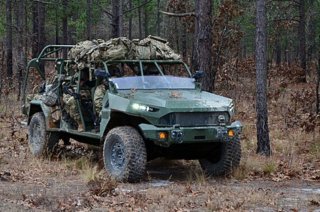The Army's New ISV is Built for Versatility, Not Comfort.
Packing nine fully-loaded infantrymen into a midsize pickup comes with some drawbacks.
Here's What You Need to Remember: With versatility and flexibility for commanders in mind, the Army had specific size and weight requirements for the ISV design to meet. It needed to be light enough to be transported by a UH-60 Black Hawk as a sling load, and both small and light enough to be carried inside a CH-47 Chinook.
The Army’s new Infantry Squad Vehicle (ISV) is currently being tested in the unforgiving desert at Yuma Proving Ground (YPG). The ISV, essentially a modified 2020 Chevy Colorado midsize pickup, is intended to be a lightweight off-road vehicle that can transport a squad of up to nine infantrymen to combat areas.
The ISV is designed specifically with the needs of the Army’s Infantry Brigade Combat Teams (IBCTs) in mind. IBCTs are defined by their ability to conduct dismounted operations at a moment’s notice in complex terrain. Mobility and timeliness are obviously important elements of the IBCTs meeting mission requirements, so the Army saw the need for a vehicle that could insert them into the fight while preserving them from some of the fatigue of movement on foot.
“It has always been coined as a better boot,” said Steven Herrick, the Army’s product lead for ground mobility vehicles. “It is a mode of transportation that effectively changes the game on how soldiers deploy and get to their objectives.”
In August of 2019, the Army initiated a competition between three teams to come up with a design to fill this need for a lighter squad vehicle. GM Defense won out over an Oshkosh Defense-Flyer Defense team, as well as a design from SAIC and Polaris. GM Defense was awarded the $214.3 million contract for 649 vehicles in June of last year, with the Army’s ultimate goal being a total of 2,065 ISVs.
With versatility and flexibility for commanders in mind, the Army had specific size and weight requirements for the ISV design to meet. It needed to be light enough to be transported by a UH-60 Black Hawk as a sling load, and both small and light enough to be carried inside a CH-47 Chinook. The ISV is also durable enough for low-velocity air drops from a C-130 or C-17.
The vehicle’s constitution is 90% parts that would be found on the assembly line for a 2020 Chevrolet Colorado ZR2. The 186-horsepower, 2.8L Duramax turbo-diesel engine enables the new transport to negotiate challenging terrain with a payload of up to 3200 pounds.
The ISV, however, has drawn plenty of criticism, as well. Packing nine fully-loaded infantrymen into a midsize pickup comes with some disadvantages. The Department of Defense published its DOT&E (Director, Operational Test and Evaluation) report in January, and found significant flaws with the ISV despite it outperforming its competitors.
The report says, “The lack of internal space to carry soldiers with their rucksacks in seats, mission-essential equipment, and sustainment loads may create a logistics and operational burden. This limits the type and duration of missions for which an ISV may be effective.”
Other shortcomings DOT&E noted were the lack of reliable communication for ISV units, who would instead need to rely on handheld or manpack radios (though mounted communication was not an Army requirement), and the lack of an underbody/ survivability requirement to deal with roadside bombs and other hostile actions will leave the ISV vulnerable to attack in situations where squads can’t use its speed and maneuverability as a defense. The DOT&E recommended that at least a plan to address these issues be in place before production, which is slated to begin next month at GM Defense’s facility in Concord, North Carolina.
Until last month, the ISV’s testing and development were taking place on the East Coast. The intense Yuma heat and rocky terrain is another relevant hurdle considering the operational theater the Army is seeking the ISV for. There are nine different prototypes being run through a battery of tests at the massive proving ground, including evaluations of its slope mobility and cooling systems, with the goal of being finished sometime next month, according to Isaac Rodriguez, team leader for YPG’s combat automotive division.
“Before the soldier ever touches the vehicle, we want to make sure that it is safe for them to use,” Rodriguez told the Yuma Sun.
It’s important to note the DOT&E report also acknowledged how useful the new ISV can be, stating:
“The ISV provides enhanced off-road mobility capability and enables infantry units to be less predictable in their movement necessary to accomplish airborne; air assault; offensive; and engagement, security cooperation, and deterrence (ESD) missions. The ISV expands a light infantry unit’s area of operations.”
The DOT&E is bound to find some problems to address in any new program. Soldiers will undoubtedly have some affectionate nicknames for the ISV as they climb in and out of their cramped transport, but service members are famously crafty and adaptable, and will always find a way to make the equipment work even if it is a less than luxurious ride. The Army clearly believes in the ISV, and has time to make tweaks and add growth capabilities to its requirements, as they put it through their own tests at YPG and then its Initial Operational Testing and Evaluation (IOT&E) in August at Fort Bragg, North Carolina.
The first 59 ISVs are bound for the 1st Infantry Brigade Combat Team of the 82nd Airborne Division (which specializes in parachute assault operations) at Fort Bragg later this year, with the plan to eventually outfit 11 IBCTs with 59 ISVs each.
This article was first published by Sandboxx.
Image: Wikimedia Commons

